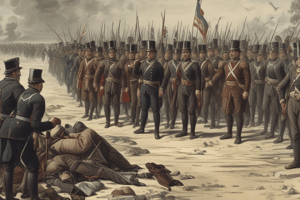Podcast
Questions and Answers
What was one of the causes of the Crisis of the Third Century?
What was one of the causes of the Crisis of the Third Century?
- Declining population
- Vast size of the empire made centralized rule difficult (correct)
- Increase in agricultural productivity
- Centralized rule was easy to maintain
The Tetrarchy was introduced to replace the Roman Senate.
The Tetrarchy was introduced to replace the Roman Senate.
False (B)
Who was the first Christian emperor of Rome?
Who was the first Christian emperor of Rome?
Constantine I
In 313 CE, the Edict of _____ granted religious freedom to all, including Christians.
In 313 CE, the Edict of _____ granted religious freedom to all, including Christians.
What was a key result of the Battle of the Milvian Bridge?
What was a key result of the Battle of the Milvian Bridge?
What vision did Constantine have before the Battle of the Milvian Bridge?
What vision did Constantine have before the Battle of the Milvian Bridge?
What were the main causes of the Crisis of the Third Century?
What were the main causes of the Crisis of the Third Century?
What did the provincialization of the empire involve?
What did the provincialization of the empire involve?
Who introduced the Tetrarchy and in what year?
Who introduced the Tetrarchy and in what year?
What does the term 'Tetrarchy' mean?
What does the term 'Tetrarchy' mean?
Who were the two senior emperors in the Tetrarchy?
Who were the two senior emperors in the Tetrarchy?
Who was the first Christian emperor of the Roman Empire?
Who was the first Christian emperor of the Roman Empire?
Christianity was initially a dominant religion in the Roman Empire.
Christianity was initially a dominant religion in the Roman Empire.
What significant event occurred at the Battle of the Milvian Bridge?
What significant event occurred at the Battle of the Milvian Bridge?
What was the Edict of Milan?
What was the Edict of Milan?
What are some legacies of Constantine I?
What are some legacies of Constantine I?
Flashcards
Crisis of the Third Century
Crisis of the Third Century
A period of immense turmoil and instability in the Roman Empire during the 3rd century CE.
Provincialization of the Empire
Provincialization of the Empire
Shift in Roman power from central government to provinces, marked by devaluing currency and other key changes.
Tetrarchy
Tetrarchy
Diocletian's rule of four; a system of co-emperors aiming to improve administration.
Constantine I
Constantine I
Signup and view all the flashcards
Edict of Milan
Edict of Milan
Signup and view all the flashcards
Great Persecution
Great Persecution
Signup and view all the flashcards
Early Christianity
Early Christianity
Signup and view all the flashcards
Constantinople
Constantinople
Signup and view all the flashcards
Council of Nicaea
Council of Nicaea
Signup and view all the flashcards
Military Spending
Military Spending
Signup and view all the flashcards
Barbarian Tribes
Barbarian Tribes
Signup and view all the flashcards
Roman Empire's Size
Roman Empire's Size
Signup and view all the flashcards
Polytheistic Religion
Polytheistic Religion
Signup and view all the flashcards
Monotheistic Religion
Monotheistic Religion
Signup and view all the flashcards
Military Structure
Military Structure
Signup and view all the flashcards
Inflation
Inflation
Signup and view all the flashcards
Study Notes
Crisis of the Third Century
- The Roman Empire faced a period of turmoil known as the Crisis of the Third Century (300-600 CE).
- The empire's vast size and the pressure from external forces like Barbarians and Persians contributed to difficulties in centralized rule.
- The empire's inefficient military structure also exacerbated the crisis.
- To solve these problems, the empire expanded its standing army along its borders, which led to issues in funding and recruitment.
Provincialization of the Empire
- The Crisis of the Third Century resulted in the "provincialization" of the empire.
- This involved devaluing currency, leading to inflation.
- Tax revenues shifted to the provinces rather than going to the central government.
- Declining birth rates and plagues further weakened the empire.
- The empire recruited soldiers from the outer regions rather than Rome itself.
- Barbarian tribes were granted permission to settle within the empire's borders.
The Tetrarchy
- Emperor Diocletian established the Tetrarchy in 293 CE to address these challenges.
- The tetrarchy meant "rule of four" and divided the empire into four administrative divisions.
- Diocletian ruled the east as Augustus and Maximian ruled in the west.
- Galerius and Constantius Chlorus served as Caesars in the east and west respectively.
- The system aimed to improve administrative efficiency, expedite responses to threats and establish a clear succession plan.
- While initially successful, power struggles weakened the system in the long run.
Constantine I and the Rise of Christianity
- Constantine I (r. 306-337 CE), the first Christian emperor, had a significant impact on the Roman Empire and European history.
- Prior to Constantine, Rome followed a polytheistic religion, with state officials serving as priests.
- Christianity emerged in Palestine around 0 CE and initially remained a minority religion.
- Its message of universal salvation, regardless of social status, contributed to its rising popularity among marginalized groups in Roman society.
The Great Persecution of Christians
- Emperor Diocletian launched a "great persecution" of Christians in 304 CE.
- This persecution involved the destruction of Christian scripture and churches, mandatory sacrifices to Roman gods, the stripping of titles and offices, and execution of Christians.
Constantine's Vision and the Edict of Milan
- Constantine I emerged victorious in the Battle of Milvian Bridge in 312 CE after confronting his rival Maxentius.
- According to legend, Constantine saw a vision of a shining cross with the words "In this sign, you will conquer."
- This victory led to the Edict of Milan in 313 CE, which granted religious freedom to all, including Christians.
- The Edict of Milan represented a turning point in the relationship between Rome and Christianity, ultimately paving the way for Christianity to become the empire's dominant religion.
Constantine’s Legacy
- Constantine played a crucial role in setting the stage for the spread of Christianity.
- He moved the capital of the Roman Empire from Rome to Constantinople (modern-day Istanbul) in 330 CE.
- He convened the Council of Niceae in 325 CE to address theological disputes among Christians.
- He also engaged in extensive programs of church building in Rome.
Crisis of the Third Century
- The Roman Empire faced a period of turmoil from the 3rd century CE.
- Causes included vast size hindering centralised rule, pressure from Barbarian tribes and Persians, and difficulty sustaining a large military.
- To address these issues, the Roman Empire expanded its military which led to financial and manpower issues.
Provincialization of the Empire
- The crisis of the 3rd century led to the "provincialization" of the Roman Empire.
- This included:
- Debasing currency, causing inflation.
- Tax revenues flowing to provinces rather than the central government.
- Declining birth rates and plague outbreaks.
- Recruiting soldiers from the borders of the empire rather than Rome itself.
- Allowing Barbarian tribes to settle within the empire's borders.
The Tetrarchy
- Emperor Diocletian introduced the Tetrarchy in 293 CE.
- This system divided the empire into four administrative units:
- Two senior emperors (Augusti): Diocletian in the East and Maximian in the West.
- Two junior emperors (Caesares): Galerius in the East and Constantius Chlorus in the West.
- The Tetrarchy aimed for administrative efficiency, rapid response to threats, and clear succession.
- While initially effective, power struggles undermined its long-term viability.
Constantine I and the Rise of Christianity
- Constantine I (r. 306-337 CE) was the first Christian emperor.
- Constantine's conversion and policies had a profound impact on the Roman Empire and European history.
Early Christianity
- Roman religion was initially polytheistic.
- Christianity, a monotheistic religion, originated in Palestine around 0 CE and was initially a minority religion.
- Christianity's message of salvation for all contributed to its growing popularity, particularly among marginalised groups.
Diocletian's Persecution of Christians
- Emperor Diocletian initiated a "great persecution" of Christians in 304 CE.
- This included destruction of scriptures and churches, mandatory sacrifices to Roman gods, stripping titles, and executions.
The Battle of Milvian Bridge and the Edict of Milan
- Constantine I confronted his rival Maxentius at the Battle of the Milvian Bridge in 312 CE.
- Legend states Constantine had a vision of a shining cross, leading to his victory.
- The Edict of Milan in 313 CE granted religious freedom for all, including Christians.
- This marked a turning point in the relationship between Christianity and the Roman state, paving the way for Christianity's dominance.
### Constantine's Legacy
- Laid the groundwork for the spread of Christianity.
- Moved the capital of the Roman Empire from Rome to Constantinople (modern-day Istanbul) in 330 CE.
- Convened the Council of Niceae in 325 CE to address theological disagreements within Christianity.
- Engaged in extensive church-building programs in Rome.
Studying That Suits You
Use AI to generate personalized quizzes and flashcards to suit your learning preferences.




